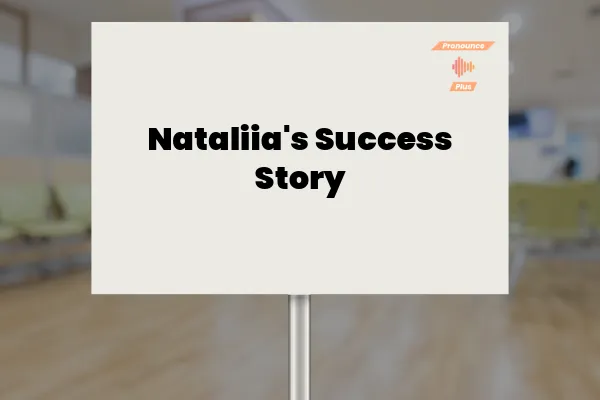
Nataliia's Success Story
A Common Problem for Students Refining Their American English Pronunciation Skills
Nataliia is an adult English learner from Ukraine. When we first met during a Level 1 class I was teaching in 2015, her English was limited, and had her speaking confidence was low.
By the time we reconnected in the spring of this year, Nataliia's English had improved significantly.
However, she still felt unsure about her pronunciation and wanted to have more confidence as she spoke English.
What Happened As I Began to Tutor Nataliia
When we began working together again, Nataliia was part of a small group class with her good friend, which helped her feel more comfortable speaking.
To build her confidence, we started with sounds that are easier to practice and hear, like the /th/ sound. This gave Nataliia a way to begin noticing how she improved.
We also focused on the /ng/ sound, which she ended with a hard /g/ sound.
Nataliia felt frustrated as we practiced because she had not known before that the hard /g/ isn’t pronounced. She still catches herself saying the hard /g/ at the end of /ng but is gradually making improvement with feedback.
From individual sounds, we began working on stress and reductions, focusing on reducing grammar words like “to” or “and.”
Nataliia also practiced breaking sentences into smaller pieces called thought groups and stressing the last noun in each thought group.
During our conversations, her comfort level increased, and she began self-correcting, which showed that Nataliia was able to feel the sounds and rhythm of English in ways she hadn’t when we started.
How Practicing With A Tutor Helped Nataliia Make Real Progress
As we continued working together, Nataliia made progress speaking with the rhythm of American English. This improved her ability to both speak clearly and understand proficient speakers.
She also began noticing these patterns more when watching TV or speaking with others.
Nataliia also learned how to produce the American English /r/ sound.
We spent time working on this difficult sound, both in isolation and combined with vowel sounds, which can change the /r/ sound.
Through practice, Nataliia learned how to pronounce the /r/ without tapping her tongue to the roof of her mouth, which made her speaking sound more natural.
What Tutoring Helped Nataliia Achieve
Nataliia's wanted to further develop her ability to read with natural rhythm and intonation. In her role as a carer for young children, being able to read stories was important to her.
Over time, she learned how to read with the up and down rhythm of American English while incorporating some intonation patterns into her reading , such as those used in wh-questions.
Natalliia would read a passage on her own first and then receive feedback, which helped her make better progress. This allowed her to hear the difference in her pronunciation in real time and adjust and make changes quickly.
Nataliia’s Feedback
Nataliia expressed her satisfaction with our lessons, saying:
"These lessons improved my English level, I started [to] speak similar like a native speaker since I had so bad [an] accent."
As an ESL teacher who works with speaking skills, it is my belief that no accents are bad.
Everyone has an accent.
The goal of working with a tutor is to speak so you can easily be understood, which does not mean you have to lose your accent if you don’t want to.
The goal is to build clarity and improve your speaking skills in American English and meet your individual speaking goals.
Working with Nataliia has been a pleasure.
Her willingness to practice and receive feedback has been important in her progress.
It’s been a privilege to watch her grow more confident and capable as she builds her English communication skills.
I’d love to hear your story and help you build your confidence in speaking English. Let’s start this journey together—contact me today to take the first step.